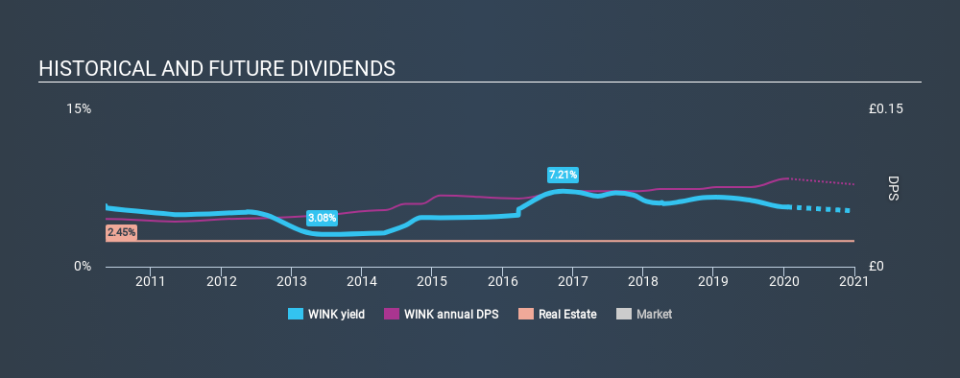Why You Should Leave M Winkworth PLC (LON:WINK)'s Upcoming Dividend On The Shelf

Some investors rely on dividends for growing their wealth, and if you're one of those dividend sleuths, you might be intrigued to know that M Winkworth PLC (LON:WINK) is about to go ex-dividend in just 3 days. You can purchase shares before the 23rd of January in order to receive the dividend, which the company will pay on the 20th of February.
M Winkworth's next dividend payment will be UK£0.021 per share, and in the last 12 months, the company paid a total of UK£0.076 per share. Calculating the last year's worth of payments shows that M Winkworth has a trailing yield of 5.7% on the current share price of £1.475. Dividends are a major contributor to investment returns for long term holders, but only if the dividend continues to be paid. So we need to check whether the dividend payments are covered, and if earnings are growing.
View our latest analysis for M Winkworth
If a company pays out more in dividends than it earned, then the dividend might become unsustainable - hardly an ideal situation. Its dividend payout ratio is 83% of profit, which means the company is paying out a majority of its earnings. The relatively limited profit reinvestment could slow the rate of future earnings growth We'd be concerned if earnings began to decline. A useful secondary check can be to evaluate whether M Winkworth generated enough free cash flow to afford its dividend. Dividends consumed 63% of the company's free cash flow last year, which is within a normal range for most dividend-paying organisations.
It's encouraging to see that the dividend is covered by both profit and cash flow. This generally suggests the dividend is sustainable, as long as earnings don't drop precipitously.
Click here to see how much of its profit M Winkworth paid out over the last 12 months.
Have Earnings And Dividends Been Growing?
Companies that aren't growing their earnings can still be valuable, but it is even more important to assess the sustainability of the dividend if it looks like the company will struggle to grow. If earnings decline and the company is forced to cut its dividend, investors could watch the value of their investment go up in smoke. It's not encouraging to see that M Winkworth's earnings are effectively flat over the past five years. Better than seeing them fall off a cliff, for sure, but the best dividend stocks grow their earnings meaningfully over the long run.
Many investors will assess a company's dividend performance by evaluating how much the dividend payments have changed over time. Since the start of our data, ten years ago, M Winkworth has lifted its dividend by approximately 6.3% a year on average.
Final Takeaway
Has M Winkworth got what it takes to maintain its dividend payments? While earnings per share are flat, at least M Winkworth has not committed itself to an unsustainable dividend, with its earnings and cashflow payout ratios within reasonable bounds. With the way things are shaping up from a dividend perspective, we'd be inclined to steer clear of M Winkworth.
Curious about whether M Winkworth has been able to consistently generate growth? Here's a chart of its historical revenue and earnings growth.
If you're in the market for dividend stocks, we recommend checking our list of top dividend stocks with a greater than 2% yield and an upcoming dividend.
If you spot an error that warrants correction, please contact the editor at editorial-team@simplywallst.com. This article by Simply Wall St is general in nature. It does not constitute a recommendation to buy or sell any stock, and does not take account of your objectives, or your financial situation. Simply Wall St has no position in the stocks mentioned.
We aim to bring you long-term focused research analysis driven by fundamental data. Note that our analysis may not factor in the latest price-sensitive company announcements or qualitative material. Thank you for reading.


